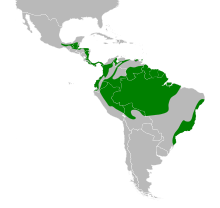Green honeycreeper
The green honeycreeper (Chlorophanes spiza) is a small bird in the tanager family. It is found in the tropical New World from southern Mexico south to Brazil, and on Trinidad. It is the only member of the genus Chlorophanes. The purplish honeycreeper (Chlorophanes purpurascens), a bird from Venezuela known only from the type specimen, is now thought to be an intergeneric hybrid between the green honeycreeper and either the red-legged honeycreeper or the blue dacnis.[2]
| Green honeycreeper | |
|---|---|
_male.jpg) | |
| Adult male C. s. spiza, Trinidad | |
| Scientific classification | |
| Kingdom: | Animalia |
| Phylum: | Chordata |
| Class: | Aves |
| Order: | Passeriformes |
| Family: | Thraupidae |
| Genus: | Chlorophanes L. Reichenbach, 1853 |
| Species: | C. spiza |
| Binomial name | |
| Chlorophanes spiza (Linnaeus, 1758) | |
 | |
| Synonyms | |
| |
Description
The green honeycreeper is 13–14 cm (5-5.5 in) long and weighs 14 to 23 grams, averaging about 19 grams. It has a long decurved bill. The male is mainly blue-tinged green with a black head and a mostly bright yellow bill. The female green honeycreeper is grass-green, paler on the throat, and lacks the male's iridescence and black head. Immatures are plumaged similar to females. The call is a sharp chip.
The species name spiza derives from the Ancient Greek word σπίζα (spíza), a catch-all term for finch-like birds.[3][4]
Behavior
This is a forest canopy species. The female green honeycreeper builds a small cup nest in a tree, and incubates the clutch of two brown-blotched white eggs for 13 days. It is less heavily dependent on nectar than the other honeycreepers, fruit being its main food (60%), with nectar (20%) and insects (15%) as less important components of its diet.
References
- BirdLife International (2012). "Chlorophanes spiza". IUCN Red List of Threatened Species. 2012. Retrieved 26 November 2013.CS1 maint: ref=harv (link)
- Storer, Robert W. (1957). "The Hybrid Origin of Chlorophanes purpurascens" (PDF). Auk. 74 (4): 507. doi:10.2307/4081756.
- Bailly, Anatole (1981-01-01). Abrégé du dictionnaire grec français. Paris: Hachette. ISBN 978-2010035289. OCLC 461974285.
- Bailly, Anatole. "Greek-french dictionary online". www.tabularium.be. Retrieved March 12, 2019.
Further reading
- ffrench, Richard (1991). A Guide to the Birds of Trinidad and Tobago (2nd ed.). Comstock Publishing. ISBN 0-8014-9792-2.
- Hilty, Steven L (2003). Birds of Venezuela. London: Christopher Helm. ISBN 0-7136-6418-5.
External links
| Wikimedia Commons has media related to Chlorophanes spiza. |
- Green honeycreeper videos on the Internet Bird Collection
- Stamps (for Guyana, Suriname, Trinidad and Tobago) with RangeMap
- Green Honeycreeper photo gallery VIREO
- Photo-High Res; Article tsgcs.co.uk
